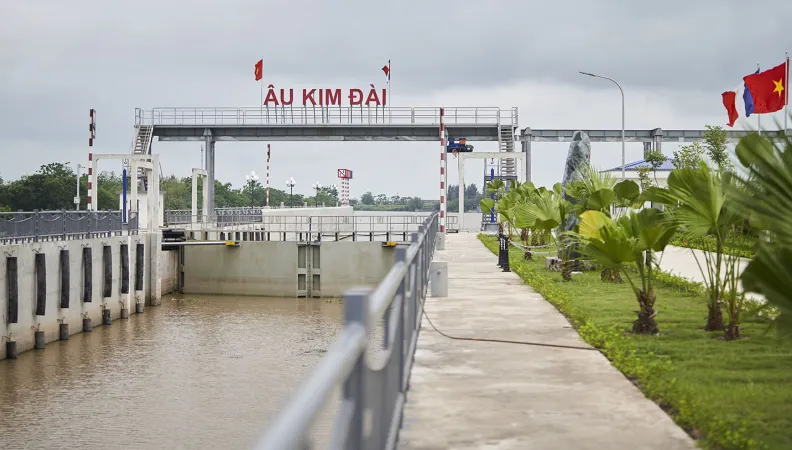Share the page
In Vietnam, Vital Infrastructure fends off the Effects of Climate Change
Published on

South of Hanoi in the province of Ninh Binh, Vietnam, rising sea levels are causing the salinization of fresh water. Infrastructure was desperately needed to prevent the situation from worsening, and to preserve precious fresh water. Earlier this year, AFD funded a new dam, which was inaugurated in late March.
Near the coastlines of Vietnam, Ninh Binh’s rice fields stretch as far as the eye can see – a perennial figure of the country’s landscape. As unchanging as the scenery may seem, farmers are engaged in a race against time to arrest rising sea levels. Salt water is seeping into the Day River and salinizing the freshwater canals used for agriculture and domestic consumption, with disastrous consequences on crops and the daily life of locals.
To address the increasingly urgent problem, plans were drafted to build a dam in Kim Dai, Ninh Binh province, and financed by AFD. It’s an essential piece of infrastructure for the province’s resilience to the effects of climate change.
Adapting to climate change
"Last year, between November and April, we faced major freshwater shortages due to the infiltration of salt water from the Gulf of Tonkin,” says Ngoc Thinh Pham, Director of the Agriculture Project Management Unit of Ninh Binh Province.
The shortages could worsen as climate change continues. "Water is rising up to 15 kilometers from the mouth of the Day River, a figure that could double to 30 km by 2030 according to our forecasts,” says Pham. “Salt concentration has also increased in recent years, a trend that is expected to continue. This phenomenon is affecting several thousand hectares today, and could affect tens of thousands more if we do nothing."
In response, the province has built four such dams to prevent saltwater from entering the region’s rivers. Kim Dai's dam is the last, but also the most important.
Immediate results
Mr. Thanh Binh Hoang, 47 years old, heads a producers’ cooperative. His family has been farming for generations, and he has seen the consequences of salinization firsthand: "We have already lost entire crops to salt,” he says. “And even in our daily use, salt makes everything rust, pumps break down."
For him, the dam produced results almost as soon as it was installed last October. "This year, we had enough fresh water to cultivate our land. We didn't even have to pump water like in other years!"
The floodgate also helps regulate water levels in the event of floods or droughts, to which the province is highly vulnerable.
A new breath
This installation has brought relief to some 830,000 inhabitants of the province. "My whole family works in agriculture and the benefits of this installation are very important for us,” says Gia Thoai Tran, a 64-year-old farmer. “In addition to facilitating production, our living conditions are improved, and everything is simpler for cooking and showering for example.” Perhaps most important, "thanks to the increased availability of fresh water, we will be able to increase the surface of our rice fields, and thus increase our income. This will allow us to invest in new machinery to facilitate production!”
Blocking salt water - but not river transport
The specificity of the Kim Dai structure and its three similar facilities - one of which was financed by the AFD - is that in addition to preventing salt water intrusion, it includes a lock to allow boats to pass through.
"On average, there are about ten boats passing through every day, carrying mainly construction materials such as sand or stones,” says Anh Thai Tran, Vice Director of the Kim Phat Company, which built the structure. “This allows for the continuation of river transport, but limits the intrusion of salt water into the river."
It is part of a larger project to combat rising water levels in the provinces of Can Tho, Ninh Binh and Ha Tinh, financed by a loan of more than €52 million and a grant of €1 million.
